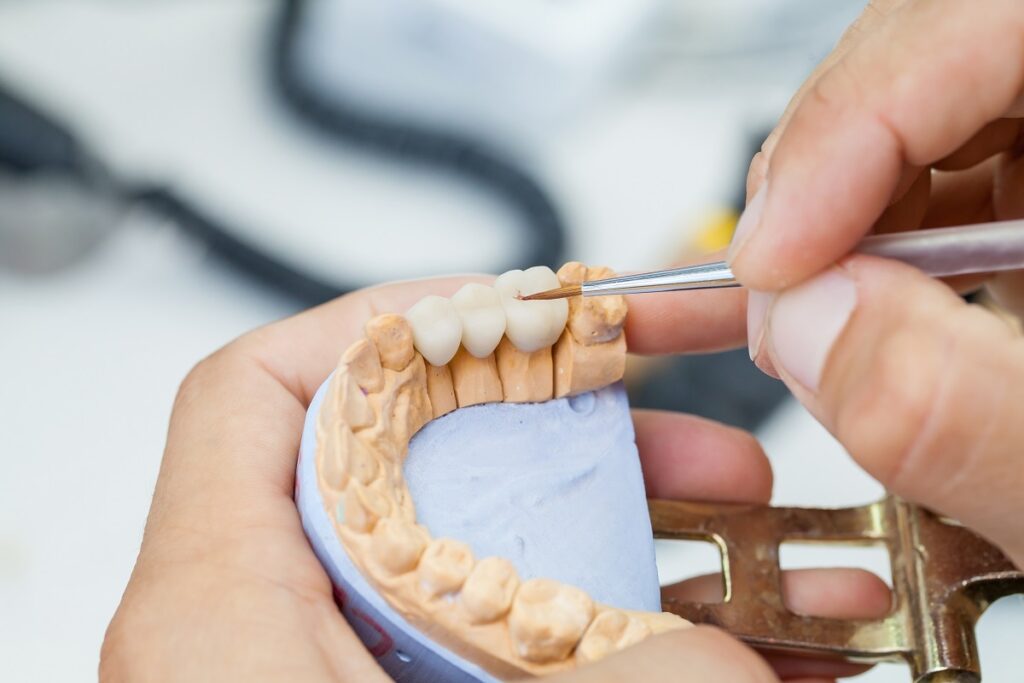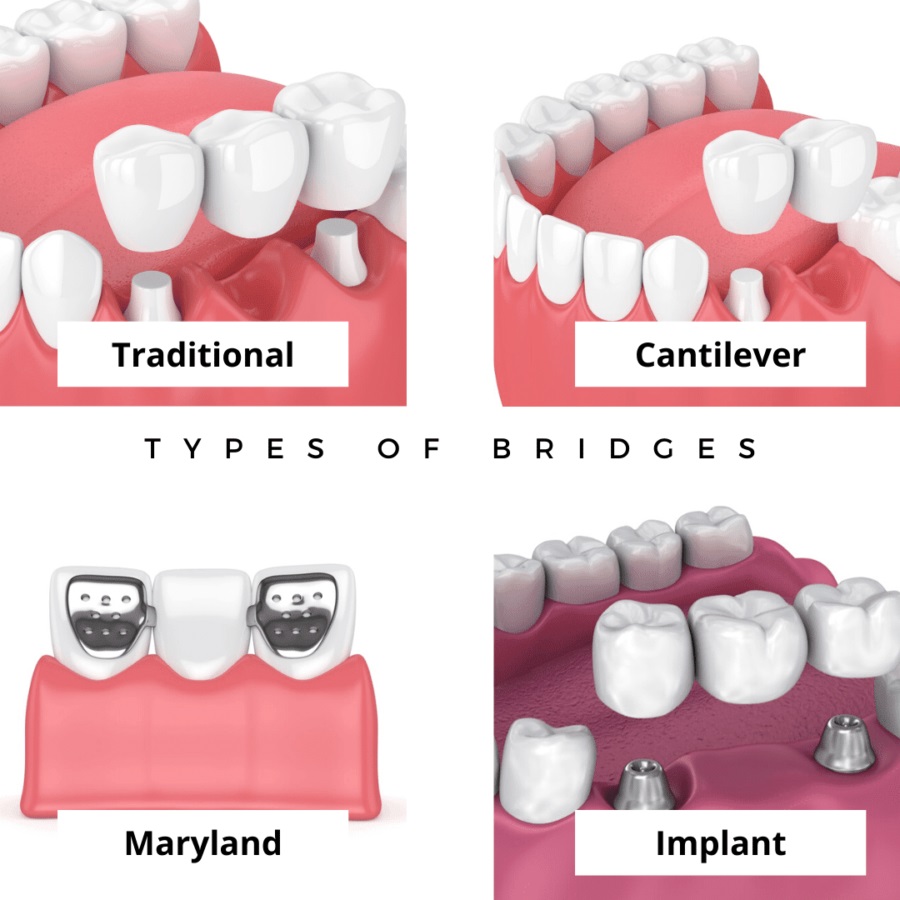Cosmetic Dentistry
Dental Bridges
Dental Bridges in Scottsdale, AZ
Tooth loss is a common issue for adults, but dental bridges offer a reliable solution. This well-known method can replace missing teeth, restoring both form and function. The process is efficient, typically completed in a few office visits, quickly bringing back the natural look and feel of your smile.

Over 178 million Americans are missing at least a single tooth. It’s tempting sometimes to save the expense and hassle of replacing a missing tooth, but that can have negative implications for your overall dental health. A dental bridge is a great way to replace a missing tooth or teeth and improve your smile which is why Dr. Wiitala is excited to offer patients the option of our dental bridges procedure. To find out if this treatment is right for you, read our FAQ:

Frequently asked questions about dental bridges
A bridge is a dental prosthetic that “bridges” the gap of your missing tooth/teeth. The bridge consists of crowns on the healthy teeth on each side of the gap (these are also called the abutment teeth). Between the crowns is an artificial tooth or teeth (called pontics) that replace the missing teeth. Bridges are anchored by healthy abutment teeth or by dental implants. Dr. Eric Wiitala prefers porcelain for the crowns and artificial teeth because porcelain closely mimics the translucence and light reflection of natural tooth enamel.
It’s tempting to put off replacing a missing tooth, particularly if it’s a molar that isn’t readily visible. But that’s a bad idea for a variety of reasons. First, teeth stay put due to the pressure placed on them by neighboring teeth. When a tooth is missing, the adjacent teeth tend to slide over into the gap. This creates alignment and bite problems.
Here are the reasons for having a bridge replace a tooth or teeth:
- To complete your smile
- To prevent adjacent teeth from moving
- To restore chewing and biting capability
- To distribute the bite forces to not overload other teeth
- To restore your speaking diction
- To maintain the shape of your face
Patients who are missing at least one tooth that has fallen out or been extracted are great candidates for the dental bridges procedure. Their remaining teeth must be strong and healthy, and cannot have gum disease or other oral health conditions that may affect the procedure.
A well-made dental bridge does not pose a threat to the gums nor the jawbone. It should be understood, however, that a dental bridge cannot reverse or prevent bone loss. The natural teeth and their roots stimulate bone regeneration by transferring the force of chewing as vibrations to the jawbone. When a tooth is lost, that transfer of vibration goes away and, as result, the jawbone starts to recede.
Most often, dentists use traditional dental bridges to replace one or two adjacent teeth. However, in some cases, a bridge can be made to replace up to four teeth. The objective of treatment is to restore appearance as well as the best possible chewing function. It is necessary for the bridge to be able to withstand the force of normal biting. To achieve this goal, the dentist may limit the number of teeth included in the bridge.
If your dental exam and consultation determine that you are a good candidate for a dental bridge, you may prepare for your treatment by contacting your insurance company for coverage amounts. In terms of oral care, continue brushing and flossing normally. You may need to stop taking certain medications and supplements to reduce the risk of bleeding.
Receiving a bridge from Dr. Wiitala involves two office visits. During your first appointment, we prepare the abutment teeth for their crowns. First, we need to make room for the crowns, so Dr. Wiitala shaves off a portion of the enamel from the healthy teeth on all sides and the top. The crowns will completely cover the natural teeth down to the gumline. We then take impressions and photos of your teeth to send to the dental lab to use when fabricating your bridge. While we are awaiting your bridge, we place a temporary bridge that we make in-house also using your impressions.
Once your bridge is finished, you return for your second appointment. Dr. Wiitala checks its fit and color match with your natural teeth. He adjusts the fit as needed. If you desire, we can place the bridge with temporary cement so that you can try out the fit for a day or two at home. Once satisfied, your bridge is permanently cemented onto your abutment teeth and you’re finished.
Dental bridge treatment is not associated with any major side effects. Patients can expect minor symptoms such as discomfort, swelling, and tooth sensitivity during the course of treatment. These symptoms are easy to manage with good aftercare and over-the-counter medication as needed. While post-procedure side effects are generally short-lived, it may some time to adjust to the dental bridge. Patients can return to work and most normal activities within 24 hours of receiving a bridge. However, it may take one to two weeks to get used to the feel of the crowns and artificial teeth in the mouth. Some patients experience a slight change in speech after getting a dental bridge. This is a temporary effect that resolves as the tongue and cheeks acclimate to the new structures. If discomfort or other side effects persist beyond two weeks, it is a good idea to contact our office to have the bridge evaluated and adjusted if necessary.
During the brief recovery phase after dental bridge treatment, comfort can be managed with medication as well as the use of cold compresses to the side of the cheek. Patients should avoid very hot, very cold, and very hard or chewing substances while getting used to their new bridge.
The average lifespan of a dental bridge can last a patient between five to 15 years, making this procedure worth it for many patients. With the proper care and maintenance, however, dental bridges can last even longer than fifteen years.
Just like any other dental procedure, there are always some side effects from the procedure such as soreness, increased sensitivity, or an unfamiliar feeling in the mouth in the first few days of having your bridges. If a dental bridge is implanted wrong, however, this can lead to bridge failure, oral pain, infection boils, gum recession around the bridge, and difficulty chewing or swallowing.
To avoid these risks and complications, Dr. Wiitala and his team provide excellent patient care, providing comfort and guidance during each part of your dental journey.
If you have always wanted to fix your smile, be more confident, and not have to hide your face when you laugh, dental bridges may be the next step into not only transforming your appearance but also your life. Dental bridges benefit most patients by restoring their confidence and giving them back the smile they used to have before they lost their teeth.
There are only two options for replacing a missing tooth or teeth, a bridge or a dental implant. Bridges, sometimes called partial dentures if replacing a series of missing teeth, are more affordable than implants. For most patients replacing a series of teeth with individual implants is not really feasible. Bridges also are relatively quick procedures, requiring two not overly long appointments. The implant process takes a few months.
The goal of having a bridge is to replace one or more missing teeth. This completes your smile once again, and it gives you the benefits described above for replacing missing teeth. It keeps your adjacent teeth in place and allows you to eat a full diet.
Compared to a dental implant, replacing a single tooth or even two teeth with a bridge has certain disadvantages. Bridges are more fragile than implants, as they can break when the person eats really hard foods. They can also dislodge when eating sticky foods (although Dr. Wiitala can cement the bridge back down should this happen).
The other main disadvantage to a bridge is its lifespan. Dental implants are generally considered to be lifetime replacements, meaning they will typically last the remainder of the patient’s life. Bridges usually last from 5 to 15 years, depending on the patient’s choice of foods and home hygiene. They can last longer, but most people will need a bridge replaced at least once.
There really isn’t any discomfort when Dr. Wiitala is preparing your teeth for your bridge or when placing it. Local anesthetic is used when the teeth are shaved down to make room for the crowns.
Dental bridges have a varying lifespan from five to 15 years, but they can last longer. The health of the abutment teeth is usually the determinant. With good home hygiene, bridges can last a long time.
Dental bridges are replacements for your natural teeth. If you have had more than one tooth extracted, lost a molar due to a traumatic injury, or have a congenital absence, you may require a dental bridge.
Yes, there are several types of dental bridges you can have.
The types of dental bridges include the following:
- Traditional bridges.
- Cantilever bridges.
- Maryland bridges.
- Implant-supported bridges.
While each of these bridges aims to accomplish the same thing, they do differ from each other. Traditional bridges are the most common type of bridges and are used to fill in the empty space. However, dentists usually use traditional bridges for patients with healthy teeth on both sides of their mouth.
Cantilever bridges work similarly to traditional bridges, except they only have one crown on the end. These bridges are also not as durable as their traditional counterpart. Maryland bridges do not use crowns; instead, they use metal wings. These wings are bonded to the back of your teeth so they remain in place. Maryland bridges are typically used for a patient’s front teeth as they are not strong enough to handle the bite force of the back teeth.
Implant-supported bridges are also similar to traditional bridges, with the only difference being that they are bonded to dental implants instead of natural teeth. Dental implants act as substitutes for missing tooth roots. The implant must be fully bonded to a patient’s jawbone before they can receive these bridges.
The type of dental bridges you need depends on your situation. Dr. Eric Wiitala will consider a number of factors, such as your age, the number of teeth you are missing, how big the gap is, the health of your teeth, and what you personally prefer.
Dental bridges can help you replace missing teeth, but you still need to take care of them all the same. This means brushing your teeth at least twice a day, floss once a day, and schedule routine dental checkups.

Other types of bridges
The bridge we described above is a traditional bridge. Dr. Wiitala also uses two other types of bridges depending on patient needs.
- Cantilever bridges — When there are healthy teeth on just one side of the missing teeth, a cantilever bridge is used. Two crowns are placed on the one side and the bridge in this case is more akin to a balcony.
- Maryland bridges — These bridges are typically used on the front teeth. Maryland bridges don’t use crowns as anchors. Instead, bands are cemented to the back surfaces of the supporting teeth.
Kind Words From Proud Patients
Love, love, love Dr Wiitala and my hygienist, Andrea. They are the best! I don’t even mind going to the dentist anymore, and that’s saying a lot. Whole staff is amazing!
Excellent service. Caring, professional, friendly and excellent skills. I travel from Portland Or to see Dr Wiitala and his team. They are the best. Highly recommend Dr Wiitala and his team.
Dr. Wiitala and his staff definitely deserve five stars or more! The friendliness and professionalism shown by everyone in this office is amazing! I would have no hesitation in recommending them for your dental needs
never thought I would say I really enjoyed a visit to the dentist but here I am. These guys are amazing‼️ Totally professional and yet friendly and accommodating. So thankful a friend recommended me to them. Now I am recommending them😃 Thank you guys, Sadie, Lindsey, Dr. Wiitala and entire team for a job well done 👍
As usual, Dr Wiitala provided superlative dental care. Should be in TOP DOCS of Phoenix! Always efficient, knowledgeable, and professional.
The dentist Eric Wiitala and the office staff are excellent. Friendly, making sure the customer is comfortable and very professional staffers. They are honest and thorough.
Dr. Wiitala, Andrea the hygienist, and staff, were all amazing! I had such a pleasant experience! After a change of insurance and a move, it took a while to find a dental office that I actually look forward to coming back to regularly. lucky to have found this gem of an office!
Great staff and Dr. Wiitala is very professional and personable
Dr Wiitala and his staff are the best – friendly, professional and knowledgeable. My family has been going to Dr Wiitala for a decade or more. It’s the best dental office ever.
Professional, excellent experience as always. Dental hygienist, Andrea thoroughly cleaned my teeth and Dr. Wiitala identified filling in need of repair before it would become a major problem down the road. This is reason I’ve been a client of Dr. Wiitala for 15+ years.
